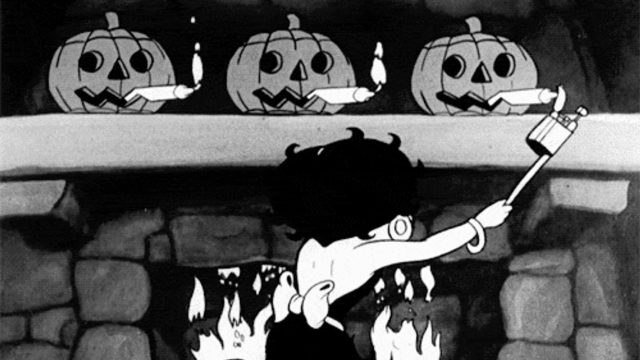My assessment of the Fleischers as overrated earlier might seem harsh, but sampling five of the fourteen Betty Boop shorts the brothers released in 1933 confirmed the impression I got the last time I tried to venture beyond their canonical masterpieces. They certainly can’t match the breakneck inventiveness of Snow White. Betty Boop’s Ker-Choo stops dead for one of its bare six minutes so Betty can pimp Universal Records’ latest novelty song. Snow White quite literally moved a gag (if not two or three) a second, but the closest we get for this excruciatingly long minute are some racing spectators jostling for seats and the judges’ booth falling over to reveal the bearded judges are wearing diapers (ha…ha?).
The same goes for Betty Boop’s Crazy Inventions, a snail’s-paced film that just lets each machine do whatever it says on the label for thirty seconds at a time, often by looping the same footage we’ve already seen, the kind of corner-cutting that would horrify Disney. But at least Crazy Inventions makes up for it by building to a memorably bizarre punchline, where Koko’s sewing machine goes haywire, trapping the audience inside the exhibition tent and sewing up ditches, rivers, and turning a stork, a school of fish, and a turtle into some kind of animal human centipede.
But moments like that are few and far between, and they point to the fatal flaw of the lesser Betty Boop shorts — they’re too darned normal for their own good. Snow White’s dreamlike structure made it obvious the Fleischers were throwing logic to the four winds. But the other Bettys follow plots so linear they make the occasional strange interlude seems more like the Fleischers tried and failed to make a straighforward movie. A gag like a hippo opening his mouth to reveal the entrance to the downtown train in Betty Boop’s Hallowe’en Party would have seemed clever, if not hilarious, in the rapid-fire surrealism of Snow White, but lingered on for so long in such an otherwise ordinary cartoon, it just inspires confusion.
And that’s one of the better Bettys, integrating cartoon absurdity much more effectively in its first act, where a scarecrow decorates Betty’s house with “cat paint” and “witch paint” that forms into the appropriate shape as he splatters it on the wall and Betty makes Jack O’Lanterns by calling down a tiny cat on a string who pulps the pumpkins by pedaling an eggbeater, letting a cow stab out the eyes with its horns, sticking candle in the pumpkins’ closed mouths, lighting them with a cigarette lighter on a stick, and letting them come to life and swallow them.
The scarecrow himself is a great addition to the cast, faceless but still expressive, and a perfect showcase for the Fleischers’ trademark “rubber hose” style of loose-limbed animation. Also added to the cast: a bully gorilla, no doubt inspired by Kongamania. And if the ghosts that chase him away don’t really seem to come from anywhere, at least they look cool.
On the less successful side, we have Is My Palm Read, which has a fortune-teller’s-booth framing device so clumsily integrated I had to double-check the main plot wasn’t recycled from an earlier cartoon. More confusing still, the ghosts Bimbo predicted would chase Betty suddenly appear in his tent, and even more confusingly than that, chase them across the island landscape we’d last seen in the crystal ball. Palm also includes a flashback to Betty’s infancy, but since her appearance is already disturbingly babylike, it’s hard to shake the impression some local perv just wanted an excuse to draw her naked, and quite frankly, it would have been a lot less uncomfortable with the adult Betty.
The best of the second-string Bettys suggests the Fleischers needed Calloway far more than he needed them. They may have helped sell his records, but he was their muse. He plays a double role here as an owl warning Betty of the old man and the old man himself, who the animators go to town on even when they’re not rotoscoping Calloway, his face warping horribly as he moves towards and away from the audience like a fleshy funhouse mirror. His cavernous home isn’t quite as elaborate as Snow White’s mystery cave, but it’s still packed with creepy skeletons and artful ink-wash atmosphere. And even when Calloway’s not onscreen, he seemed to have inspired the Fleischer staff to bring their A-game. Old Man features a series of inspired, rapid-fire gags of woodland critters fleeing the Old Man — two rabbits coiling their ears aroudn a lion’s ankle so he can use them as roller skates, a squirrel opening up a safe inside a safe inside a safe inside a safe inside a safe to retrieve a single nut — and if it’s not Snow White, it’s close enough for horseshoes and hand grenades.
There’s still the uncomfortable undercurrent of sexual violence here (and, as we’ll see, even in the supposed kid-friendly Mickey Mouse cartoons). The chase has always been the classic backbone of the Golden Age cartoon, but watching the Old Man pursue Betty is more disturbingly familiar than wild animals devouring each other, even if the end goal of the chase remains just as demurely offscreen.


